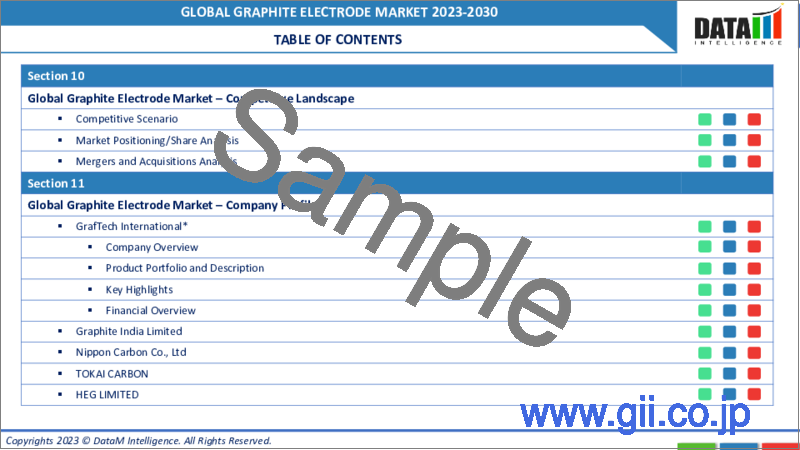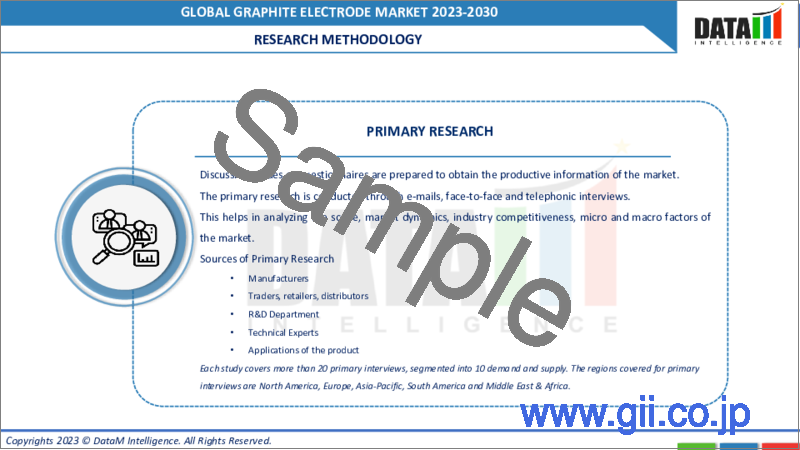|
|
市場調査レポート
商品コード
1290385
グラファイト電極の世界市場-2023-2030Global Graphite Electrode Market - 2023-2030 |
||||||
カスタマイズ可能
適宜更新あり
|
|||||||
| グラファイト電極の世界市場-2023-2030 |
|
出版日: 2023年06月12日
発行: DataM Intelligence
ページ情報: 英文 189 Pages
納期: 即日から翌営業日
|
- 全表示
- 概要
- 目次
市場の概要
グラファイト電極の世界市場は、2022年に81億米ドルに達し、2023-2030年の予測期間中に6.2%のCAGRで成長し、2030年には130億米ドルに達すると予想されています。
電気炉は、その低コスト、柔軟性、環境への影響の低減により、従来の高炉よりも人気を博しています。電気炉は、製鉄に必要な熱を発生させるためにグラファイト電極を利用します。世界の鉄鋼業界では、電気炉への移行が徐々に進んでおり、グラファイト電極の需要増に繋がっています。
2022年12月12日、国産技術によるリチウムイオン電池の販売でBIS認証を取得したGODI India社が、シリコン負極技術によるエネルギー密度275Wh/kgのインド初の5.2Ah 21700円筒型リチウムイオン電池を生産しました。
市場開拓の要望を受け、国産開発チームが電極組成を開発しました。シリコンはグラファイトに比べてエネルギー密度が高いため、電気自動車では1回の充電で15~20%ほど航続距離が延びる可能性があります。したがって、インドは2022年の地域別市場シェアの1/4以上を占め、予測期間中に大きなCAGRで成長すると予想されます。
市場力学
電気炉へのシフト
EAFへのシフトは、平炉や塩基性酸素炉(BOF)などのレガシーな製鉄技術の段階的な廃止も後押ししています。これらの古い技術は、時代遅れで環境に優しくないため、EAFに取って代わられつつあります。グラファイト電極は、BOFでは必要ありませんが、EAFでは必要不可欠です。したがって、多くの鉄鋼メーカーがレガシー技術からEAFに移行するにつれて、グラファイト電極の需要が増加します。
例えば、鉄鋼業界が二酸化炭素排出量の削減に積極的な欧州では、BOFが廃止される一方で、EAFの使用が増加しています。このようなEAFへの移行により、同地域ではグラファイト電極の需要が急増しています。
電池性能を向上させる材料への需要の高まり
リチウムイオン電池は、イオニシルを15%添加することで、実用上20%容量が増加し、1回の充電で走行できる距離の増加につながります。これは、グラファイト電極にイオニシルを配合することで、電気自動車の走行距離の延長に貢献できることを示唆しています。
したがって、本コンテンツでは、イオニシルをグラファイト電極に組み込むことで、リチウムイオン電池の性能向上、エネルギー貯蔵容量の増加、電気自動車の走行距離の延長を、競争力のあるコストで実現し、世界のグラファイト電極市場を牽引する可能性があるとしています。
原材料価格のボラティリティ
原材料価格の変動は、ニードルコークスのような主要な投入物の入手と供給にも影響を及ぼします。価格が非常に不安定な場合、グラファイト電極メーカーは、原材料の安定的かつ信頼できる供給を確保する上で困難に直面する可能性があります。その結果、生産の遅延、リードタイムの増加、潜在的な供給不足が生じ、市場の成長を阻害する可能性があります。
原材料価格が大きく変動した場合、グラファイト電極メーカーは製品の安定的な価格設定を行うことが困難になる可能性があります。原材料価格が急激に上昇した場合、メーカーはグラファイト電極の価格を引き上げることで追加コストを顧客に転嫁しようとする可能性があります。しかし、この場合、エンドユーザーにとって電極の価格が低くなり、需要の減少や市場の成長の鈍化につながる可能性があります。
COVID-19の影響分析
パンデミックの影響を受けた需給力学は、市場の不確実性とともに、グラファイト電極業界の価格変動につながっています。需要の減少や供給過剰により、当初は価格が下落しました。しかし、需要が回復し、サプライチェーンに課題が残る中、価格は安定し始め、場合によっては上昇することさえありました。価格の変動は、メーカーと消費者の双方にとって、コスト管理および事業計画上の課題となっています。
ロシア・ウクライナ戦争による影響分析
戦争による供給の混乱と不確実性は、グラファイト電極市場の価格変動につながる可能性があります。価格の変動や供給不足は、鉄鋼、アルミニウム、電気自動車製造などグラファイト電極に大きく依存する産業の収益性や計画性に影響を与える可能性があります。
欧州はグラファイト電極の重要な消費地であり、いくつかの主要な鉄鋼生産国がこの地域に位置しています。ロシアやウクライナからのグラファイト電極の供給が途絶えた場合、欧州の産業やその生産需要への対応に影響を与える可能性があります。そのため、欧州の消費者は他の地域からグラファイト電極を調達することを検討し、市場力学が変化する可能性があります。
人工知能の影響分析
AIは、グラファイト電極業界の研究開発を加速させることができます。膨大な量のデータを分析することで、AIアルゴリズムは新素材の特定、電極設計の最適化、製造プロセスの改善を行い、製品の性能と耐久性の向上につなげることができます。AIは、グラファイト電極製造におけるエネルギー消費の最適化にも貢献します。エネルギーの使用パターンを分析し、最適化の機会を特定することで、AIシステムはエネルギーコストを削減し、持続可能な製造手法に貢献することができます。
したがって、AIは欧州および世界のグラファイト電極市場に革命をもたらす可能性を秘めています。需要予測の強化、生産プロセスの最適化、品質管理の向上、サプライチェーン管理の合理化、価格戦略の最適化、研究開発の加速、エネルギー効率の促進を実現するのです。
目次
第1章 調査手法とスコープ
- 調査手法
- 調査目的および調査範囲
第2章 定義と概要
第3章 エグゼクティブサマリー
第4章 市場力学
- 影響要因
- 促進要因
- 電気アーク炉への移行
- 電池の性能を向上させるための材料に対する需要の高まり
- 抑制要因
- 原料価格の変動
- 機会
- 影響分析
- 促進要因
第5章 産業分析
- ポーターのファイブフォース分析
- サプライチェーン分析
- 価格分析
- 法規制の分析
第6章 COVID-19の分析
第7章 タイプ別
- レギュラーパワー(RP)
- ハイパワー(HP)
- ウルトラハイパワー(UHP)
第8章 アプリケーション別
- 電気アーク炉(EAF)
- ラドルファーネス(LF)
- その他
第9章 地域別
- 北米
- 米国
- カナダ
- メキシコ
- 欧州
- ドイツ
- 英国
- フランス
- イタリア
- ロシア
- その他欧州
- 南米
- ブラジル
- アルゼンチン
- その他南米地域
- アジア太平洋地域
- 中国
- インド
- 日本
- オーストラリア
- その他アジア太平洋地域
- 中東・アフリカ地域
第10章 競合情勢
- 競合シナリオ
- 市況/シェア分析
- M&A(合併・買収)分析
第11章 企業プロファイル
- GrafTech International
- 会社概要
- 製品ポートフォリオと説明
- 財務概要
- 主な発展状況
- Graphite India Limited
- Nippon Carbon Co., Ltd
- TOKAI CARBON
- HEG LIMITED
- Kaifeng Carbon Co., Ltd
- JILIN CARBON
- SHOWA DENKO K.K.
- SANGRAF International
- Misano Group
第12章 付録
Market Overview
The Global Graphite Electrode Market reached US$ 8.1 billion in 2022 and is expected to reach US$ 13.0 billion by 2030 growing with a CAGR of 6.2% during the forecast period 2023-2030.
Electric arc furnaces have gained popularity over traditional blast furnaces due to their lower cost, flexibility and reduced environmental impact. EAFs utilize graphite electrodes to generate the heat required for steelmaking. The global steel industry has been witnessing a gradual shift towards EAFs, leading to an increased demand for graphite electrodes.
On December 12, 2022, the first 5.2 Ah 21700 cylindrical lithium-ion cells ever made in India with an energy density of 275 Wh/kg based on silicon anode technology were produced by GODI India, a corporation that received BIS certification to sell lithium-ion cells made with domestically developed technology.
According to market demands, an indigenous development team developed the electrode composition. Due to the higher energy density of silicon compared to graphite, an electric car might have a range up to 15-20% greater on a single charge. Therefore, India accounted for more than 1/4rd of the regional market shares in 2022 and is expected to grow at a significant CAGR during the forecasted period.
Market Dynamics
Shift Towards Electric Arc Furnaces
The shift towards EAFs is also driven by the phasing out of legacy steelmaking technologies, such as open-hearth furnaces and basic oxygen furnaces (BOFs). These older technologies are being replaced by EAFs due to their outdated and less environmentally friendly nature. Graphite electrodes are not required in BOFs, but they are indispensable for EAFs. Hence, as more steel producers transition from legacy technologies to EAFs, the demand for graphite electrodes grows.
For instance, in Europe, where the steel industry has been actively reducing its carbon footprint, the use of EAFs is increasing while BOFs are being phased out. This transition towards EAFs has resulted in a surge in demand for graphite electrodes in the region.
Growing Demand for Materials to Enhance the Battery Performance
15% Ionisil substitution can result in a lithium-ion battery with 20% more capacity in practical applications, leading to an increase in the number of kilometers that can be driven per charge. This implies that incorporating Ionisil into graphite electrodes can contribute to the advancement of electric vehicles by extending their driving range.
Therefore, the content suggests that the incorporation of Ionisil in graphite electrodes has the potential to drive the global graphite electrode market by offering improved lithium-ion battery performance, increased energy storage capacity and enhanced driving range for electric vehicles, all at a competitive cost.
Volatility in Raw Material Prices
Volatile raw material prices can also impact the availability and supply of key inputs like needle coke. If the prices are highly unpredictable, graphite electrode manufacturers may face challenges in securing a stable and reliable supply of raw materials. This can result in production delays, increased lead times and potential supply shortages, which can hinder the growth of the market.
When raw material prices experience significant fluctuations, graphite electrode manufacturers may face difficulties in setting stable pricing for their products. If the prices of raw materials increase sharply, manufacturers may try to pass on the additional costs to customers by raising the prices of graphite electrodes. However, this can make the electrodes less affordable for end-users, potentially leading to a decline in demand and slower market growth.
COVID-19 Impact Analysis
The supply-demand dynamics affected by the pandemic, along with uncertainties in the market, led to price volatility in the graphite electrode industry. Prices initially declined due to reduced demand and excess supply. However, as demand recovered and supply chain challenges persisted, prices started to stabilize and, in some cases, even increased. Fluctuating prices posed challenges for both manufacturers and consumers in managing costs and planning their operations.
Russia-Ukraine War Impact Analysis
Supply disruptions and uncertainties caused by a war could lead to price volatility in the graphite electrodes market. Fluctuating prices and supply shortages may affect the profitability and planning of industries that heavily rely on graphite electrodes, such as steel, aluminum and electric vehicle manufacturing.
Europe is a significant consumer of graphite electrodes, with several major steel-producing countries located in the region. Any disruptions in the supply of graphite electrodes from Russia or Ukraine could impact European industries and their ability to meet production demands. This may prompt European consumers to explore alternative sources of graphite electrodes from other regions, potentially leading to shifts in market dynamics.
Artificial Intelligence Impact Analysis
AI can accelerate research and development efforts in the graphite electrodes industry. By analyzing vast amounts of data, AI algorithms can identify new materials, optimize electrode designs and improve manufacturing processes, leading to advancements in product performance and durability. AI can play a role in optimizing energy consumption in graphite electrode manufacturing. By analyzing energy usage patterns and identifying opportunities for optimization, AI systems can help reduce energy costs and contribute to sustainable manufacturing practices.
Therefore, AI has the potential to revolutionize the graphite electrodes market in Europe and globally. It enhances demand forecasting, optimizes production processes, improves quality control, streamlines supply chain management, optimizes pricing strategies, accelerates research and development and promotes energy efficiency.
Segment Analysis
The global graphite electrode market is segmented based on type, application and region.
Owing to their Superior and High-Quality Characteristics, the Ultra-High Power (UHP) Dominates the Global Graphite Electrode Market
The UHP graphite electrodes are capable of withstanding extremely high temperatures and can sustain intense electrical currents during the steelmaking process. They exhibit better mechanical strength, higher density and improved electrical conductivity compared to other types of graphite electrodes. As a result, UHP graphite electrodes are preferred for steel production methods that require high-power and efficient performance. Therefore, the ultra-high power (UHP) segment is currently the dominant type of graphite electrode in the global market, driven by its superior properties and suitability for demanding applications like steelmaking in electric arc furnaces. Additionally, high power (HP) is the second largest segment in the global graphite electrode market, acquiring nearly 1/4th of the global segmental share.
Geographical Analysis
North America's Natural Graphite Reserves and Established Manufacturing Infrastructure
North America has a well-developed manufacturing infrastructure, particularly in the United States, which supports the growth of the graphite electrode market. The region has advanced manufacturing facilities, expertise and technologies for graphite electrode production. These established capabilities allow North American manufacturers to produce high-quality graphite electrodes efficiently and meet the demands of various industries, including steel, aluminum and electric vehicles.
The presence of a strong manufacturing infrastructure promotes competitiveness, innovation and cost-effectiveness in the production process. It also enables manufacturers to cater to domestic demand and expand their export capabilities, contributing to market growth. Additionally, the U.S. accounts for more than 3/4th of the regional share and is expected to grow at the highest CAGR during the forecasted period in the region.
Competitive Landscape
The major global players include: GrafTech International, Graphite India Limited, Nippon Carbon Co., Ltd, TOKAI CARBON, HEG LIMITED, Kaifeng Carbon Co., Ltd, JILIN CARBON, SHOWA DENKO K.K., SANGRAF International and Misano Group.
Why Purchase the Report?
- To visualize the global graphite electrode market segmentation based on type, application and region, as well as understand key commercial assets and players.
- Identify commercial opportunities by analyzing trends and co-development.
- Excel data sheet with numerous data points of graphite electrode market level with all segments.
- PDF report consists of a comprehensive analysis after exhaustive qualitative interviews and an in-depth study.
- Product mapping available as Excel consisting of key products of all the major players.
The global graphite electrode market report would provide approximately 53 tables, 47 figures and 189 Pages.
Target Audience 2023
- Manufacturers/ Buyers
- Industry Investors/Investment Bankers
- Research Professionals
- Emerging Companies
Table of Contents
1. Methodology and Scope
- 1.1. Research Methodology
- 1.2. Research Objective and Scope of the Report
2. Definition and Overview
3. Executive Summary
- 3.1. Market Snippet by Type
- 3.2. Market Snippet by Application
- 3.3. Market Snippet by Region
4. Dynamics
- 4.1. Impacting Factors
- 4.1.1. Drivers
- 4.1.1.1. Shift Towards Electric Arc Furnaces
- 4.1.1.2. Growing Demand for Materials to Enhance the Battery Performance
- 4.1.2. Restraints
- 4.1.2.1. Volatility in Raw Material Prices
- 4.1.3. Opportunity
- 4.1.4. Impact Analysis
- 4.1.1. Drivers
5. Industry Analysis
- 5.1. Porter's Five Force Analysis
- 5.2. Supply Chain Analysis
- 5.3. Pricing Analysis
- 5.4. Regulatory Analysis
6. COVID-19 Analysis
- 6.1. Analysis of COVID-19
- 6.1.1. Scenario Before COVID
- 6.1.2. Scenario During COVID
- 6.1.3. Scenario Post COVID
- 6.2. Pricing Dynamics Amid COVID
- 6.3. Demand-Supply Spectrum
- 6.4. Government Initiatives Related to the Market During Pandemic
- 6.5. Manufacturers Strategic Initiatives
- 6.6. Conclusion
7. By Type
- 7.1. Introduction
- 7.1.1. Market Material Analysis and Y-o-Y Growth Analysis (%), By Type
- 7.1.2. Market Attractiveness Index, By Type
- 7.2. Regular Power (RP)*
- 7.2.1. Introduction
- 7.2.2. Market Material Analysis and Y-o-Y Growth Analysis (%)
- 7.3. High Power (HP)
- 7.4. Ultra-High Power (UHP)
8. By Application
- 8.1. Introduction
- 8.1.1. Market Material Analysis and Y-o-Y Growth Analysis (%), By Application
- 8.1.2. Market Attractiveness Index, By Application
- 8.2. Electric Arc Furnace (EAF)*
- 8.2.1. Introduction
- 8.2.2. Market Material Analysis and Y-o-Y Growth Analysis (%)
- 8.3. Ladle Furnace (LF)
- 8.4. Others
9. By Region
- 9.1. Introduction
- 9.1.1. Market Material Analysis and Y-o-Y Growth Analysis (%), By Region
- 9.1.2. Market Attractiveness Index, By Region
- 9.2. North America
- 9.2.1. Introduction
- 9.2.2. Key Region-Specific Dynamics
- 9.2.3. Market Material Analysis and Y-o-Y Growth Analysis (%), By Type
- 9.2.4. Market Material Analysis and Y-o-Y Growth Analysis (%), By Application
- 9.2.5. Market Material Analysis and Y-o-Y Growth Analysis (%), By Country
- 9.2.5.1. The U.S.
- 9.2.5.2. Canada
- 9.2.5.3. Mexico
- 9.3. Europe
- 9.3.1. Introduction
- 9.3.2. Key Region-Specific Dynamics
- 9.3.3. Market Material Analysis and Y-o-Y Growth Analysis (%), By Type
- 9.3.4. Market Material Analysis and Y-o-Y Growth Analysis (%), By Application
- 9.3.5. Market Material Analysis and Y-o-Y Growth Analysis (%), By Country
- 9.3.5.1. Germany
- 9.3.5.2. The UK
- 9.3.5.3. France
- 9.3.5.4. Italy
- 9.3.5.5. Russia
- 9.3.5.6. Rest of Europe
- 9.4. South America
- 9.4.1. Introduction
- 9.4.2. Key Region-Specific Dynamics
- 9.4.3. Market Material Analysis and Y-o-Y Growth Analysis (%), By Type
- 9.4.4. Market Material Analysis and Y-o-Y Growth Analysis (%), By Application
- 9.4.5. Market Material Analysis and Y-o-Y Growth Analysis (%), By Country
- 9.4.5.1. Brazil
- 9.4.5.2. Argentina
- 9.4.5.3. Rest of South America
- 9.5. Asia-Pacific
- 9.5.1. Introduction
- 9.5.2. Key Region-Specific Dynamics
- 9.5.3. Market Material Analysis and Y-o-Y Growth Analysis (%), By Type
- 9.5.4. Market Material Analysis and Y-o-Y Growth Analysis (%), By Application
- 9.5.5. Market Material Analysis and Y-o-Y Growth Analysis (%), By Country
- 9.5.5.1. China
- 9.5.5.2. India
- 9.5.5.3. Japan
- 9.5.5.4. Australia
- 9.5.5.5. Rest of Asia-Pacific
- 9.6. Middle East and Africa
- 9.6.1. Introduction
- 9.6.2. Key Region-Specific Dynamics
- 9.6.3. Market Material Analysis and Y-o-Y Growth Analysis (%), By Type
- 9.6.4. Market Material Analysis and Y-o-Y Growth Analysis (%), By Application
10. Competitive Landscape
- 10.1. Competitive Scenario
- 10.2. Market Positioning/Share Analysis
- 10.3. Mergers and Acquisitions Analysis
11. Company Profiles
- 11.1. GrafTech International*
- 11.1.1. Company Overview
- 11.1.2. Product Portfolio and Description
- 11.1.3. Financial Overview
- 11.1.4. Key Developments
- 11.2. Graphite India Limited
- 11.3. Nippon Carbon Co., Ltd
- 11.4. TOKAI CARBON
- 11.5. HEG LIMITED
- 11.6. Kaifeng Carbon Co., Ltd
- 11.7. JILIN CARBON
- 11.8. SHOWA DENKO K.K.
- 11.9. SANGRAF International
- 11.10. Misano Group
LIST NOT EXHAUSTIVE
12. Appendix
- 12.1. About Us and Services
- 12.2. Contact Us





